















|

|
The Solar System For I dipped into the Future, far as human eye could see; saw the vision of the world, and all the wonder that would be. -Alfred Lord Tennyson, 1842 |
Our solar system consists of an average star we call the Sun, the planets Mercury, Venus, Earth, Mars, Jupiter, Saturn, Uranus, Neptune, and Pluto. It includes: the satellites of the planets; numerous comets, asteroids, and meteoroids; and the interplanetary medium. The Sun is the richest source of electromagnetic energy (mostly in the form of heat and light) in the solar system. The Sun's nearest known stellar neighbor is a red dwarf star called Proxima Centauri, at a distance of 4.3 light years away. The whole solar system, together with the local stars visible on a clear night, orbits the center of our home galaxy, a spiral disk of 200 billion stars we call the Milky Way. The Milky Way has two small galaxies orbiting it nearby, which are visible from the southern hemisphere. They are called the Large Magellanic Cloud and the Small Magellanic Cloud. The nearest large galaxy is the Andromeda Galaxy. It is a spiral galaxy like the Milky Way but is 4 times as massive and is 2 million light years away. Our galaxy, one of billions of galaxies known, is traveling through intergalactic space.
The planets, most of the satellites of the planets and the asteroids revolve around the Sun in the same direction, in nearly circular orbits. When looking down from above the Sun's north pole, the planets orbit in a counter-clockwise direction. The planets orbit the Sun in or near the same plane, called the ecliptic. Pluto is a special case in that its orbit is the most highly inclined (18 degrees) and the most highly elliptical of all the planets. Because of this, for part of its orbit, Pluto is closer to the Sun than is Neptune. The axis of rotation for most of the planets is nearly perpendicular to the ecliptic. The exceptions are Uranus and Pluto, which are tipped on their sides.
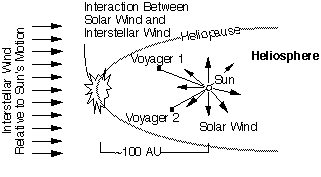 |
|---|
The solar wind can be measured by spacecraft, and it has a large effect on comet tails. It also has a measurable effect on the motion of spacecraft. The speed of the solar wind is about 400 kilometers (250 miles) per second in the vicinity of Earth's orbit. The point at which the solar wind meets the interstellar medium, which is the "solar" wind from other stars, is called the heliopause. It is a boundary theorized to be roughly circular or teardrop-shaped, marking the edge of the Sun's influence perhaps 100 AU from the Sun. The space within the boundary of the heliopause, containing the Sun and solar system, is referred to as the heliosphere.
The solar magnetic field extends outward into interplanetary space; it can be measured on Earth and by spacecraft. The solar magnetic field is the dominating magnetic field throughout the interplanetary regions of the solar system, except in the immediate environment of planets which have their own magnetic fields.
 The Terrestrial Planets
The Terrestrial Planets
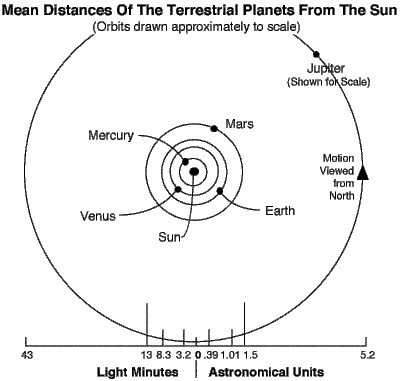 |
|---|
 The Jovian Planets
The Jovian Planets
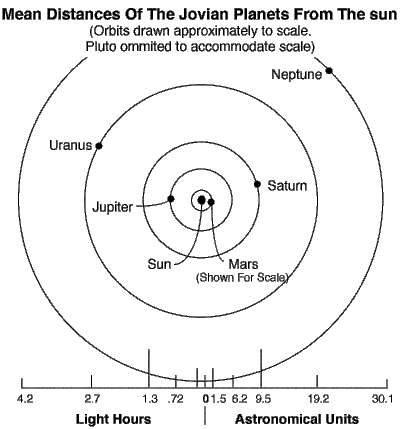 |
|---|
| Solar System Animation |
|---|
| Views of the Solar System |
|---|
 Our Milkyway Galaxy
Our Milkyway Galaxy
This image of our galaxy, the Milky Way, was taken with NASA's Cosmic
Background Explorer's (COBE) Diffuse Infrared Background Experiment
(DIRBE). This never-before-seen view shows the Milky Way from an
edge-on perspective with the galactic north pole at the top, the south pole
at the bottom and the galactic center at the center. The picture combines
images obtained at several near-infrared wavelengths. Stars within our
galaxy are the dominant source of light at these wavelengths. Even
though our solar system is part of the Milky Way, the view looks distant
because most of the light comes from the population of stars that are
closer to the galactic center than our own Sun.
(Courtesy NASA)
 Andromeda Galaxy, M31
Andromeda Galaxy, M31
The Andromeda Galaxy, M31, is located 2.3 million light years away,
making it the nearest major galaxy to our own Milky Way. M31 dominates
the small group of galaxies (of which our own Milky Way is a member),
and can be seen with the naked eye as a spindle-shaped "cloud"
the width of the full Moon.
Like the Milky Way, M31 is a giant spiral-shaped disk of stars, with a
bulbous central hub of older stars. M31 has long been known to have a
bright and extremely dense grouping of a few million stars clustered at
the very center of its spherical hub.
(Courtesy Jason Ware)
 The Solar System
The Solar System
During the past three decades a myriad of space explorers
have escaped the confines of planet Earth and have set out
to discover our planetary neighbors. This picture shows
the Sun and all nine planets of the solar system as seen
by the space explorers. Starting at the top-left corner
is the Sun followed by the planets
Mercury, Venus,
Earth, Mars,
Jupiter, Saturn,
Uranus, Neptune,
and Pluto.
(Copyright 1998 by Calvin J. Hamilton)
 Sun and Planets
Sun and Planets
This image shows the Sun and nine planets approximately to scale.
The order of these bodies are: Sun,
Mercury, Venus,
Earth, Mars,
Jupiter, Saturn,
Uranus, Neptune,
and Pluto.
(Copyright Calvin J. Hamilton)
 Terrestrial Planets
Terrestrial Planets
This image shows the terrestrial planets
Mercury, Venus,
Earth and Mars
approximately to scale. The terrestrial planets are compact, rocky,
Earth-like planets.
(Copyright Calvin J. Hamilton)
 Jovian Planets
Jovian Planets
This image shows the Jovian planets Jupiter,
Saturn, Uranus
and Neptune approximately to scale.
The Jovian planets are named because of their gigantic Jupiter-like
appearance.
(Copyright Calvin J. Hamilton)
 Diagram of Portrait Frames
Diagram of Portrait Frames
On February 14, 1990, the cameras of Voyager 1
pointed back toward the Sun and took a
series of pictures of the Sun and the planets, making the first ever
"portrait" of our solar system as seen from the outside.
This image is a diagram of how the frames for the solar system portrait
were taken.
(Courtesy NASA/JPL)
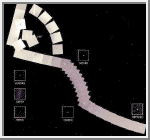 All Frames from the Family Portrait
All Frames from the Family Portrait
This image shows the series of pictures of the Sun and the
planets taken on February 14, 1990,
for the solar system family portrait
as seen from the outside. In the course of taking this mosaic
consisting of a total of 60 frames, Voyager 1
made several images of the inner solar system from a distance of
approximately 6.4 billion kilometers (4 billion miles) and about 32° above
the
ecliptic plane. Thirty-nine wide angle
frames link together six of the planets of our solar system in this
mosaic. Outermost Neptune is 30 times
further from the Sun than Earth. Our
Sun is seen as the bright object in the center
of the circle of frames. The insets show the planets magnified many
times.
(Courtesy NASA/JPL)
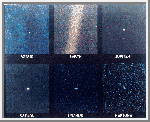 Portrait of the Solar System
Portrait of the Solar System
These six narrow-angle color images were made from the first ever
"portrait" of the solar system taken by
Voyager 1, which was more than
6.4 billion kilometers (4 billion miles)
from Earth and about 32°
above the ecliptic.
Mercury
is too close to the Sun to be seen.
Mars was not detectable by the Voyager cameras
due to scattered sunlight in the optics, and
Pluto was not included in the mosaic because of
its small size and distance from the Sun. These blown-up images, left to
right and top to bottom are Venus,
Earth, Jupiter,
Saturn, Uranus, and
Neptune.
(Courtesy NASA/JPL)
| Sun and Planet Summary |
|---|
The following table lists statistical information for the Sun and planets:
| Distance (AU) | Radius (Earth's) | Mass (Earth's) | Rotation (Earth's) | # Moons | Orbital Inclination | Orbital Eccentricity | Density (g/cm3) | |
| Sun | 0 | 109 | 332,800 | 25-36* | 9 | --- | --- | 1.410 |
|---|---|---|---|---|---|---|---|---|
| Mercury | 0.39 | 0.38 | 0.05 | 58.8 | 0 | 7 | 0.2056 | 5.43 |
| Venus | 0.72 | 0.95 | 0.89 | 244 | 0 | 3.394 | 0.0068 | 5.25 |
| Earth | 1.0 | 1.00 | 1.00 | 1.00 | 1 | 0.000 | 0.0167 | 5.52 |
| Mars | 1.5 | 0.53 | 0.11 | 1.029 | 2 | 1.850 | 0.0934 | 3.95 |
| Jupiter | 5.2 | 11 | 318 | 0.411 | 16 | 1.308 | 0.0483 | 1.33 |
| Saturn | 9.5 | 9 | 95 | 0.428 | 18 | 2.488 | 0.0560 | 0.69 |
| Uranus | 19.2 | 4 | 15 | 0.748 | 15 | 0.774 | 0.0461 | 1.29 |
| Neptune | 30.1 | 4 | 17 | 0.802 | 8 | 1.774 | 0.0097 | 1.64 |
| Pluto | 39.5 | 0.18 | 0.002 | 0.267 | 1 | 17.15 | 0.2482 | 2.03 |
* The Sun's period of rotation at the surface varies from approximately 25 days at the equator to 36 days at the poles. Deep down, below the convective zone, everything appears to rotate with a period of 27 days.